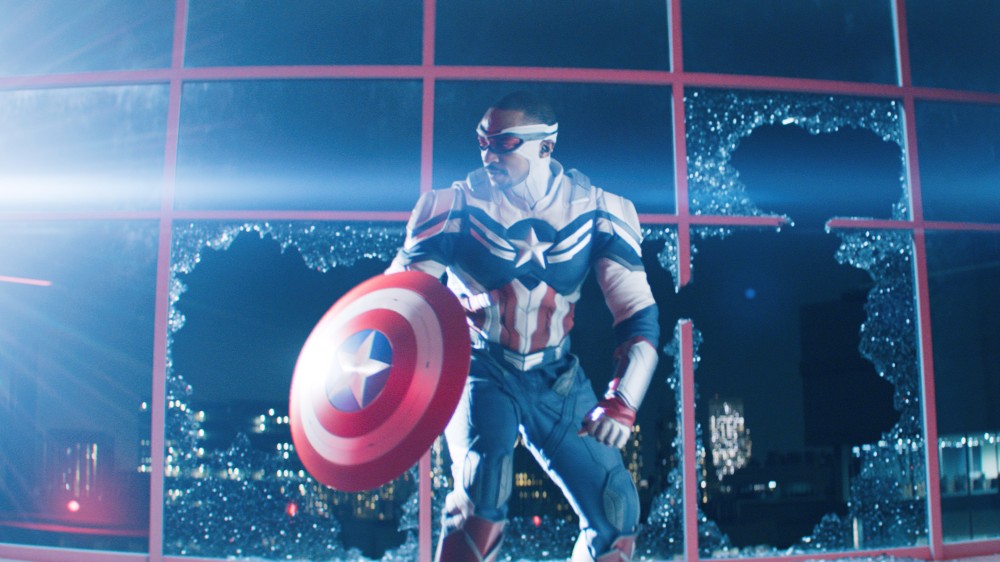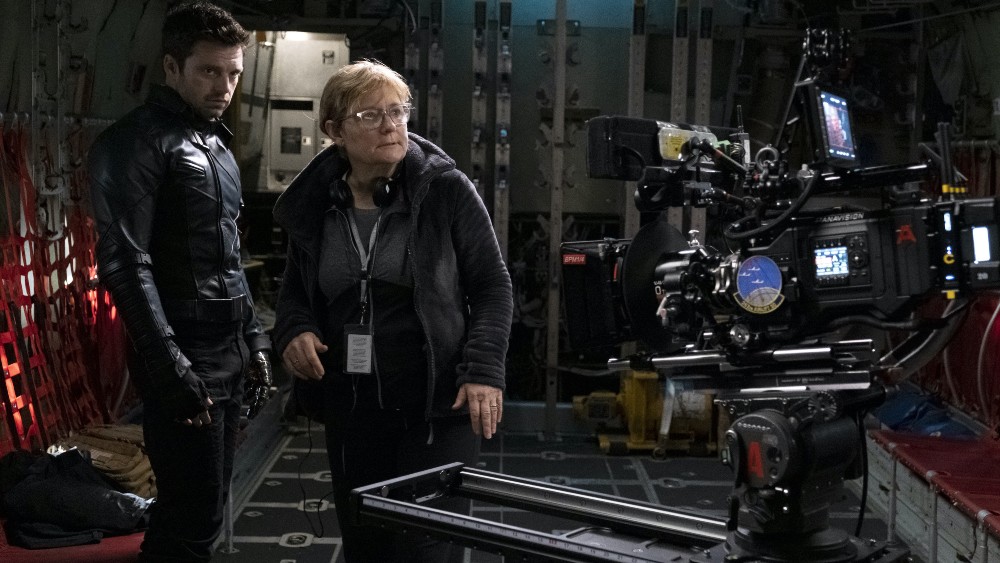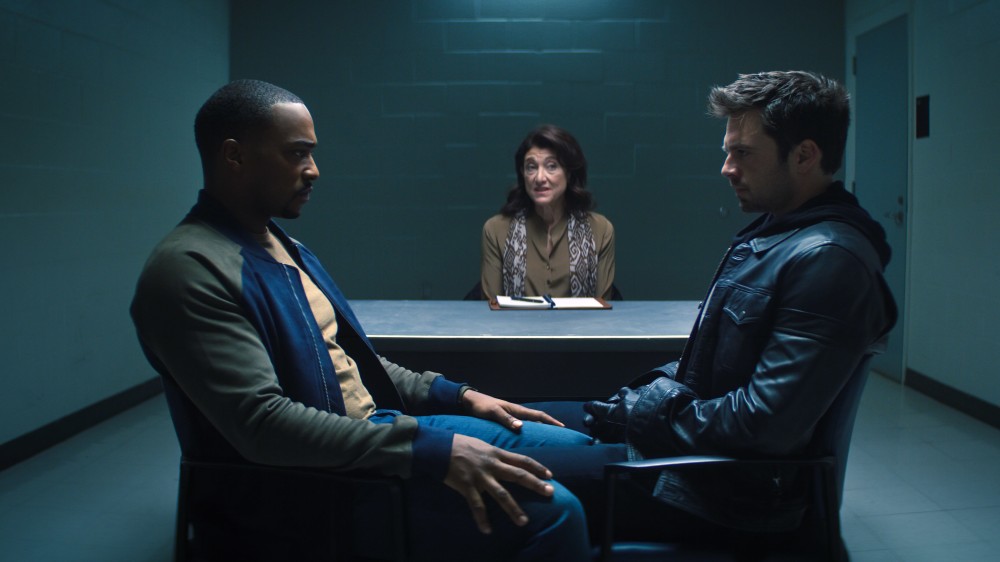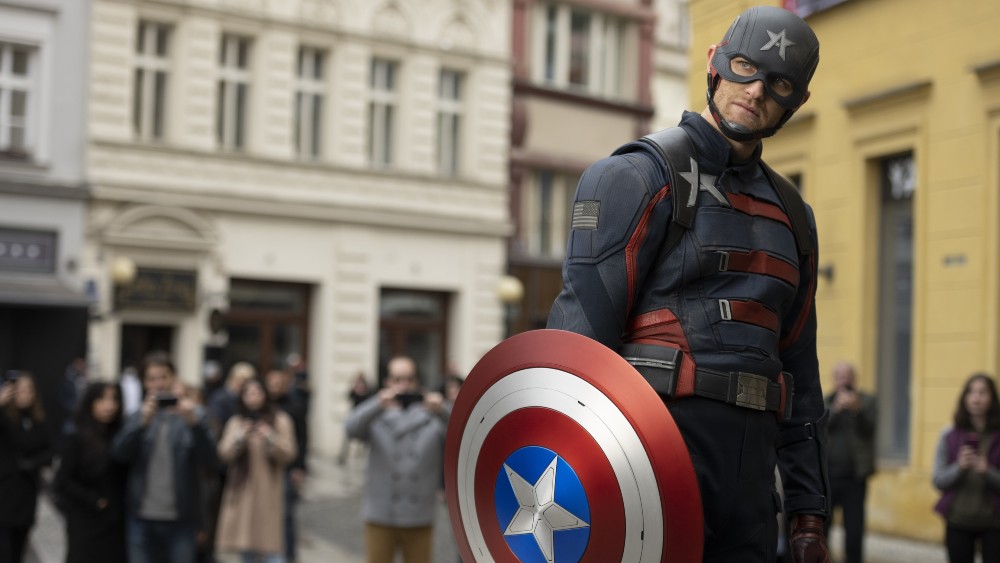
The Falcon and the Winter Soldier Creator and Head Writer Malcolm Spellman leaned on Director Kari Skogland (The Loudest Voice, The Handmaid’s Tale) to stamp that signature Marvel brand, scope, and scale for the entire six episodes of the mini-series. Skogland is a previous Emmy nominee for the work on The Handmaid’s Tale. The series further explores the development and friendship between Sam “Falcon” Wilson (Anthony Mackie) and Bucky “Winter Soldier” Barnes (Sebastian Stan) and ventures out to other topical matters. WARNING: SPOILERS AHEAD!
Before shooting, the idea of a hero was thoroughly explored and defined as the meaning has changed over the years. Skogland explained, “A hero of the Steve Rogers era was based on the idea of a warrior or a soldier that was meant to go out and kill the enemy. That was born in the comics in the1940s, which was all very relevant to anti-fascism. But now we’ve gone after 911 and the pandemics. We have first responders and frontline workers; these are all heroes. The idea of it has expanded to be broader and a far more nuanced idea. For Sam, this was also part of the journey because he has been a counselor. His whole demeanor is one of diplomacy, negotiation, and wants to know what the enemy’s thinking. Bucky is trying to carry the guilt that comes with the heinous acts that he’s committed over the many years, reconcile what that is, and how to go forward. It’s all on their journey of what is the new hero.”
It is important to note the character development with Sam and Bucky and how they transform throughout the season. “They are both searching for relevance, but from two different perspectives. Sam hangs up the shield saying this is outdated, of a former time, and not relevant anymore. He’s quite satisfied being Falcon, so he’s not compelled to try to be a Captain America with this shield. Since John Walker is given the shield, it’s now in his face and has to cope with that, as he was basically betrayed. As Sam is evaluating the shield, what it means to him, what it means to his community, and what it means for a black man to pick it up. Then we go on a journey of what the shield means to him and what it means to Bucky,” the director detailed.

The chemistry between Sam and Bucky blends together, because they have been playing the characters for a long time. “In order to get the tone right, we looked at a lot of the interviews they had between them. What’s important was improv and allowing them to bring their energy to it, so that it felt fresh and in the moment. That brought a lot of authenticity to their banter back and forth and to their friendship growing as it goes along. In Episode 2 with the couples therapy scene, we got to see their vulnerabilities. They have a common grief in the loss of their friendship with someone they loved. That sticks them together because they actually really don’t like each other or know each other. The two of them are two sides of a similar coin, in that they are both trying to go on the next path. It was a big turning point for Bucky and for Sam in Episode 5 when Bucky says to him, “how could Steve ever know what this meant because we’re not black and I’m sorry because we couldn’t possibly walk in your shoes.” Also, when Bucky comes back with the suit and needs a family; Sam becomes his family. They go on an amazing journey as friends, their friendship is galvanized, and they have each other’s back,” the filmmaker connected.
John Walker (played by Wyatt Russell) is one of the most intriguing and multi-dimensional characters within the series. Skogland characterized, “When we first went in, it was hard to decide just who he was. What was important is to understand that he wanted to do the right thing and was trained to follow orders. There was some switch missing that he couldn’t control, which was his downfall. We get a hint of that after the Dora Milaje trounce him and he can’t take it. We realize there’s a bit of an imposter in there that he is presenting as one thing, but wasn’t what it seemed. There was a gray zone to it. He’s done stuff he’s not proud of and maybe was wrong, but there was something off, and he never admitted to it. It’s through those clues that we realize he’s not Sam. Sam doesn’t have any of that, he doesn’t have dark spots inside that he hides from. Wyatt’s performance in the tribunal was amazing; and when he says “you built me and now you’re abandoning me.” These were all the nuances of this character who was incredibly complicated, but not fit for the job.”
Karli Morgenthau (played by Erin Kellyman) directly relates to the audience as she is fighting for a cause. The filmmaker depicted, “She represented the story of radicalization. She presents a slippery slope that we go down because she says things that we can completely buy, as does Sam. She’s a Robin Hood helping people, they aren’t getting hurt, and stealing from an inefficient organization to help the people that actually need the help isn’t entirely wrong. Where she starts getting radicalized is when it starts to turn and then get into territory going sideways. She’s representative of a whole much bigger movement. We can’t cut off the head of this movement, the body will still remain and get stronger. Sam sees a bigger picture, believes in her, and sees that goodness. Her character for us was really calibrating where the anger at injustice took over and became the leading bandwidth. Instead of trying to fight for justice, she started to fight for vengeance. That became a shift, which is when she became dangerous.”

The main perspectives come from Sam and Bucky, but it shifts to the other secondary characters as well. “Obviously, our two leads, Sam and Bucky, are the main focus. Then try to support perspective on another level, which was a lot of focal plane work. We were literally put into the focal plane so that we were inside whose head or where we put the camera moves. This person might be talking, but another person is in focus. We are really thinking about their character in the scene and that’s how this is impacting their character. I tried to minimize the idea of ping pong editing, as we were discovering letting a scene unfold. With editing, I wanted to have the camera find it for us, so that I chose a perspective for the scene or if we switch perspectives within the scene. Very few scenes are objective,” the director shared.
The action sequences match that ultimate expectation of the spectacular Marvel brand name. “The most challenging would have been the truck tops from the very beginning. We drove trucks with a bunch of people fighting each other and had set pieces where we could go in and do close ups and various things. It probably took the longest in the sense of all the various parts because we had to get special German trucks. I had six characters all the time and how do we cover what’s happening over there. The pit scene with the idea of putting a truck falling into a hole was its own mind melt. It took a lot of brain power and the special effects people to work the hydraulics was probably the most rigorous. In Episode 4, they’re in this creepy old building with Lemar being stolen and they all face off just before the death of Nico. We call it the horror movie because it was so atmospheric,” Skogland reflected.
The technical aspects of costume design, editing, visual effects, production design, and music are implemented to the highest level. The director praised, “Costume Designer Michael Crow was on right at the beginning. Those costumes are unbelievably detailed, they take months to not only design, but build. Probably five months went into each costume before it was on somebody’s body. They also have to be workable and be able to move in them to do the stunts. In terms of editorial, Jeff Ford was the supervising editor and he had a lot of experience with the Marvel films. He came in and galvanized the whole process and brought his wonderful expertise to it. The VFX team was with me from the beginning as Eric Leven headed up the VFX supervision and he knew exactly what he was doing with each scene as it evolved. It was never handed off to someone, he really was inside each of the moments, action sequences, and VFX. Production designer Ray Chan designed, redesigned, and figured out all the sets. We were location based, so I think he only built two sets. The rest was all sets within locations and creating something out of an empty room. He was a magician and brought to the look of it something extraordinary. Madripoor doesn’t exist, the road is one and the bridge is another bridge. We put it all together into one cohesive place. Composer Henry Jackman brought amazing music to it. We wanted to evolve the music a little bit to reflect some of the black musical elements that were going to be present in it. He did a beautiful job of figuring out the Louisiana of it, bringing that in, and then totally channeling that into the final episode where now we have a black Captain America. We also wanted to draw from some of the musical elements of his past work that came from the other movies. Although it has a real fresh edge to it, it also has some of the DNA of it is some of the historical sound of the movies.”

The show focuses heavily on race as that was a major focal point from the beginning. The filmmaker emphasized, “It was critical from the very beginning, the whole idea of a black Captain America, I felt made it the most important show of the century. When he hangs up the shield says that’s an outdated idea, that was the whole journey of what a hero is. The hero now being a first responder and a frontline worker, as compared to being a warrior soldier. It was standing on that idea and then bringing the black component into it. One of the most important lines was from Isaiah saying, “no self-respecting black man is going to pick up that shield.” Sam had to process what it means to his community, alongside what it means to the white community, and decide what he can bring to it, and does he want to? When he wipes the blood off the shield; he realizes how much in love with that symbol he is as being an iconic symbol of something that could be good and it isn’t at the moment. Who is he in that storyline to bring to it what it needs.”
Kari Skogland masterfully directs The Falcon and the Winter Soldier with that unparalleled anticipation and high caliber excellence from the Marvel brand. Skogland explores the deeper meaning behind the idea of what a hero truly is. The series presents multi-dimensional characters who have varying perspectives and strong beliefs regarding the issues they face. The journey and relationship between Sam and Bucky touch on the several levels of friendship. The most significant and pertinent theme hit home with the concept and transformation of a black Captain America.
The Falcon and the Winter Soldier is now streaming on Disney +.
All photos courtesy of Marvel Studios and Disney.
You can aso read Neil Turitz‘s latest “The Accidental Turitz” column on the Emmy chances of The Falcon and the Winter Soldier.





